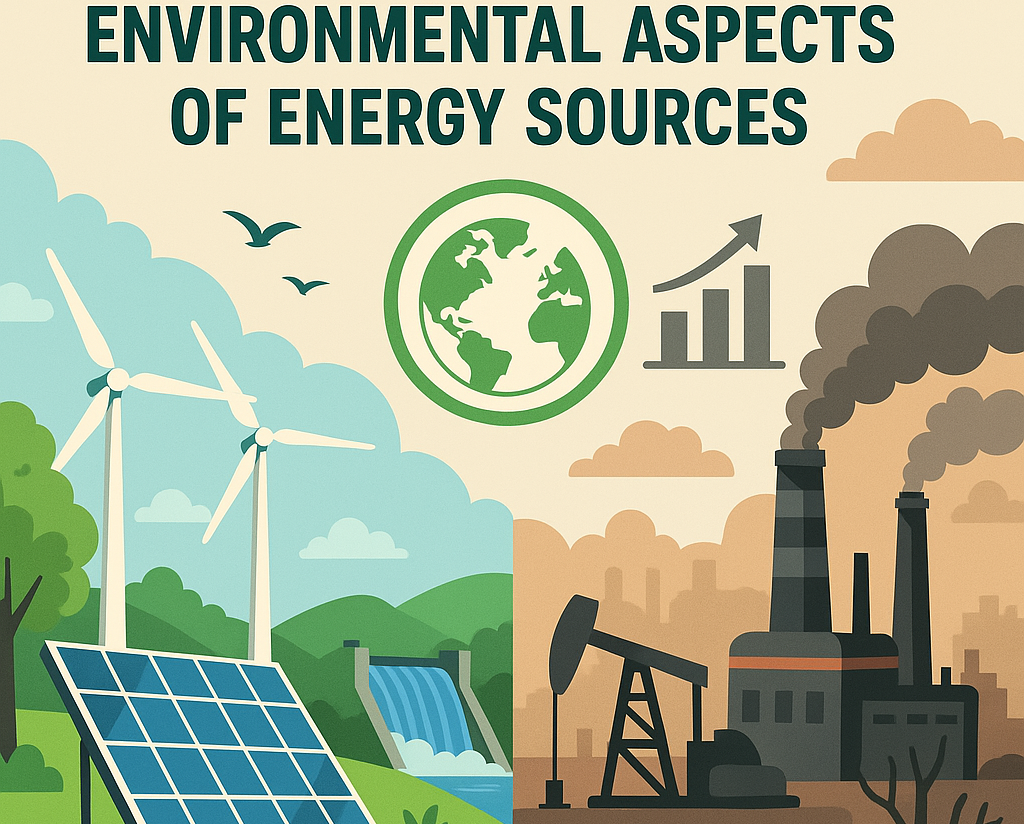Energy plays a vital role in our daily lives, fueling everything from households and transportation to industries, healthcare, education, and communication. The sources from which we derive energy have significant impacts on the environment—both positive and negative. In this article, we will explore the environmental implications of various energy sources, including fossil fuels, nuclear energy, hydropower, wind, solar, and biofuels .
Fossil Fuels: Environmental Costs and Concerns
Fossil fuels—coal, oil, and natural gas—are the most widely used energy sources across the globe. However, their environmental impact is profound and concerning. Fossil fuel combustion is a major contributor to the emission of greenhouse gases, such as carbon dioxide (CO2), which are central to climate change and global warming. The burning of these fuels also releases pollutants, leading to air quality issues, acid rain, and other environmental challenges.
In addition to greenhouse gas emissions, the extraction and transportation of fossil fuels pose significant environmental risks. Coal mining can lead to soil erosion, land degradation, and water contamination. Oil spills, which often occur during extraction and transport, can devastate marine ecosystems. Moreover, the hydraulic fracturing or “fracking” process used to extract natural gas can result in water contamination, seismic activity, and other adverse environmental effects.
Nuclear Energy: Low Carbon but High Risk
Nuclear energy is considered a low-carbon energy source, meaning it does not emit greenhouse gases during power generation. However, nuclear power is not without its environmental challenges. The mining of uranium, the fuel used in nuclear reactors, requires substantial energy and water resources and can result in soil erosion and water pollution. Additionally, the long-term management of radioactive waste remains a significant environmental issue. Radioactive materials can remain hazardous for up to 10,000 years, posing a serious threat to both human health and ecosystems.
Hydropower: Renewable but Ecosystem-Disrupting
Hydropower is a renewable energy source that generates electricity by harnessing the force of falling water. Unlike fossil fuels, hydropower does not release greenhouse gases or pollutants during generation. However, the environmental impact of hydropower can be considerable. The construction of large dams and reservoirs can lead to the displacement of people and wildlife, disrupt local ecosystems, and alter water flows, temperature, and sediment transport. Furthermore, the decomposing organic matter in reservoirs can emit methane, a potent greenhouse gas, contributing to climate change.
Wind Energy: Clean but Not without Challenges
Wind energy is a renewable power source that captures the energy of the wind to generate electricity. Wind turbines produce no greenhouse gas emissions or air pollutants, making them a highly attractive option for reducing our carbon footprint. However, the construction and operation of wind turbines can have negative environmental effects. Wind farms can fragment wildlife habitats, and there have been concerns about bird and bat fatalities due to turbine blades. Wind turbines may also generate noise pollution, which can disturb local wildlife and human populations. Additionally, the location of wind farms must be carefully considered to avoid interfering with migratory bird paths and to minimize ecosystem disruption.
Solar Energy: Clean Power with Production Costs
Solar energy, one of the most promising renewable sources, harnesses the sun’s energy to produce electricity. Solar panels do not emit any greenhouse gases during power generation, making them an environmentally friendly option. However, the manufacturing process for solar panels requires significant energy, water, and raw materials, which can have environmental repercussions, such as air and water pollution, and land degradation. Another concern is the disposal of solar panels at the end of their lifecycle, which can create environmental challenges if not properly managed.
Biofuels: Green but Not Always Sustainable
Biofuels are renewable energy sources derived from plant-based materials such as corn, soybeans, and sugarcane. Although biofuels have the potential to reduce greenhouse gas emissions when compared to fossil fuels, their environmental impact varies based on the feedstock used and production methods. The large-scale cultivation of biofuel crops can result in deforestation, habitat loss, and the use of fertilizers and pesticides that harm wildlife and pollute water sources. Moreover, the competition for land between biofuel crops and food production could lead to food security concerns.
Benefits of Renewable Energy
Renewable energy offers several notable environmental advantages. One of the primary benefits is its potential to significantly reduce greenhouse gas emissions compared to fossil fuels. According to the Intergovernmental Panel on Climate Change (IPCC), fossil fuels like coal, oil, and natural gas are the primary drivers of climate change. Renewable energy, on the other hand, generates little to no emissions, making it a key strategy in combating global warming.
Renewable energy also helps conserve natural resources. Fossil fuels are finite and will eventually be depleted, but renewable energy sources such as wind, solar, and hydropower are virtually inexhaustible. By investing in renewable energy, we can reduce our reliance on non-renewable resources and preserve them for future generations.
Furthermore, renewable energy is a major contributor to job creation and economic growth. The renewable energy sector is labor-intensive, creating millions of jobs globally. The International Renewable Energy Agency (IRENA) reports that in 2019, 11.5 million people worldwide were employed in the renewable energy industry, and this number is expected to grow substantially in the coming years.
Drawbacks of Renewable Energy
While renewable energy offers many benefits, it also comes with certain drawbacks. One of the main challenges is the intermittent nature of many renewable sources. Wind and solar energy are dependent on weather conditions—wind turbines only generate power when the wind is blowing, and solar panels only produce electricity during daylight hours. This variability can make it difficult to rely solely on renewables for a steady power supply, especially during times of peak demand.
Another issue is the environmental impact of renewable energy infrastructure. Large-scale projects such as wind farms and solar arrays can disrupt local ecosystems, fragment wildlife habitats, and require significant amounts of land, water, and other resources. Proper management and careful site selection are crucial to mitigating these effects.
Future Development of Renewable Energy
Despite these challenges, renewable energy has enormous potential for further development. One key area of focus is improving energy storage technologies, such as batteries and pumped hydro storage. These technologies will help address the issue of intermittency by storing excess energy when generation exceeds demand and releasing it when needed.
Additionally, new renewable energy sources, such as wave energy (harnessing the power of ocean waves) and hydrothermal energy (using heat from the earth’s core), are showing promise as potential solutions to meet global energy needs.
With ongoing research, innovation, and investment, renewable energy will continue to play a crucial role in reducing the harmful effects of climate change and transforming the global energy landscape.
Conclusion
While renewable energy sources each come with their own set of environmental impacts, they represent a vital part of the solution to climate change and the future of global energy. The benefits, including reducing greenhouse gas emissions, conserving natural resources, and creating jobs, far outweigh the challenges. By investing in cleaner, more sustainable energy solutions and addressing the environmental impacts associated with them, we can move toward a more resilient and sustainable future.


Leave a Reply